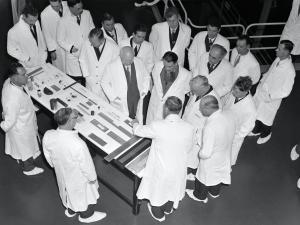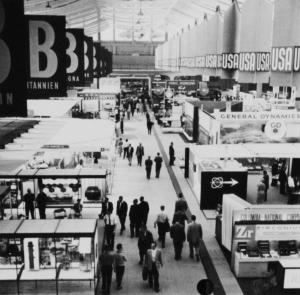"It just isn't like any other kind of research..."
On 21 April 1956, a fleet of large black limousines travelled in convoy from London to Harwell, just south of Oxford, to make an extraordinary and historic visit to the UK's Atomic Energy Research Establishment, founded ten years earlier. In one of the cars was the UK's Secretary of State for Foreign Affairs, Selwyn Lloyd, accompanied by Nikolai Bulganin, Chairman of the Council of Ministers of the USSR, and Nikita Khrushchev, First Secretary of the Communist Party. It was part of the first official state visit by the USSR to the UK since the Soviet state was founded in 1922.
Speeches were delivered in Geneva by the leading fusion scientists of the day—including Sweden's Hannes Alfvén, the USSR's Lev Artsimovich, Germany's Ludwig Biermann, the UK's (Australian-born) Peter Thonemann, and the USA's Edward Teller. As well as outlining their own countries' progress in research, they also stressed the vital importance of joint international cooperation. After the conference, 33 volumes of proceedings and papers were published. The index alone ran to some 210 pages¹.
"In the current political climate, it's important to remember that international cooperation in fusion research goes back a long way, and started long before the fall of the Iron Curtain," says Tim Luce, ITER's Head of the Science & Operation Domain. "And looking back, Atoms for Peace was the most extraordinary achievement, really, paving the way for much of the progress that has been made over the past sixty years."
One of the first big international collaborative efforts was the creation of the Joint European Torus, JET. Design work started in 1973, and in 1977 the project was given the green light by the European Commission and the facility was sited at Culham, near Oxford, just a few miles away from Harwell. By the mid-1980s, it was the largest operational magnetic confinement plasma physics experiment in the world.
At the same time, the stage was being set for the creation of ITER, a far, far bigger experiment. In November 1985, Mikhail Gorbachev and Ronald Reagan met at the Geneva Summit to hold talks on international relations and the arms race. Gorbachev proposed that an international collaborative project be created to develop fusion energy for peaceful purposes.
Less than a year later, at the Reykjavik US-USSR Summit, agreement was reached between the European Union (Euratom), Japan, the Soviet Union and the USA to jointly pursue the design for a large international fusion facility—ITER. The huge and incredibly complex project design was approved by ITER Members in 2001, and within four years China, Korea and India had also joined—meaning that Members now represent half the world's people and some 85 percent of global GDP.
"ITER is one of hundreds of fusion initiatives that have been developed since the 1950s, all around the world," says Tim Luce. "And we encourage and support each and every one of them, as they help the community as a whole to learn, and ITER in particular to do things better."
The work being done at ITER informs JET's own work and vice-versa.
"JET hit a big problem in 1997," says Alberto Loarte, who spent much of his PhD and his early post-doctoral career working at JET, before moving to ITER. "Carbon walls—as used at JET at the time—are excellent for containing high temperature plasmas producing fusion reactions, but they absorb too much of the fusion fuel."
"We persuaded the European Fusion programme for JET to adopt the ITER wall material choice, using beryllium and tungsten, for experiments to start in 2011. This was very successful in decreasing fuel absorption, but it decreased fusion power production a lot! The plasma temperature and pressure were too low for successful fusion experiments. It took more than a decade of research to resolve the issues and to get back and beyond where JET was in 1997! Changing the JET materials to mimic ITER did turn out to be the right decision—but it can take an incredibly long time to solve such complex problems, and we can only do it by working together."
Since 2008, under the auspices of ITER, the International Tokamak Physics Activity (ITPA) framework coordinates fusion research internationally. ITER also provides links to hundreds of laboratories, universities and research centres around the world which are contributing to global progress towards fusion energy².
"Fusion research is a very open field," says Alberto Loarte. "You'd be surprised how rare this is, in the world of science, or indeed any world."
He goes on to explain: "Fusion used to be plagued by single experimental results and claims which couldn't be reproduced, easily, or sometimes at all. But nowadays if you find something in fusion, your first instinct is to share it with everyone else, and then get others to try it out and see if they can validate your results. We actively want others to be successful—and they want the same for us."
"I've been working my whole professional life on this," he adds. "People have, in the past, made over-optimistic claims for fusion, but I think the approach we're taking here at ITER—being conservative and cautious in our assumptions and looking at the long-term—will deliver positive, concrete results. We don't know with high precision what those results will be, but I'm confident that through international cooperation we can demonstrate fusion power, here at ITER."
"It's fantastic to be part of the huge international team here at ITER," agrees Tim Luce. "It's an absolutely unique physics experiment, going where nobody has ever gone before.
"One of the most remarkable things about fusion research," he adds, "is that in the fusion community we've always managed to maintain bridges not just between nations that are traditionally allies, but also between nations that may be in conflict in other areas. The ITER Members may have different political and cultural systems—sometimes dramatically different—but we're all working here towards our common cause, our common goal. And that's a tremendous thing to be a part of."
¹See https://digitallibrary.un.org/record/3808554?ln=en
²See /fusionlinks
View a video of the 1956 Harwell visit here.
View a newsreel of the second Atoms for Peace Conference here.




